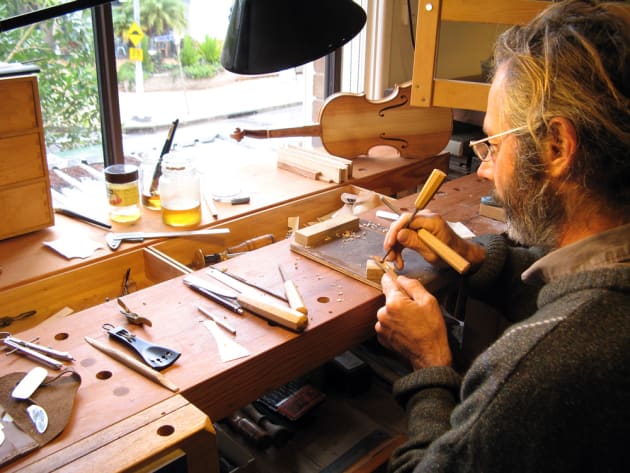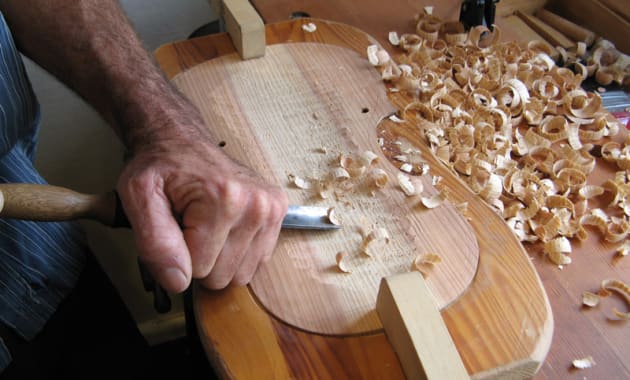The December issue of Australian Wood Review contains a feature on Treecycle 2016, an exhibition of work made from timber salvaged from the Royal Botanic Gardens, Sydney. Curators Leon and Ginny Sadubin selected 45 makers who made a total of 450 pieces of furniture and artworks. The voilin made by Mikey Floyd (above), a shipwright and luthier based in Sydney was one of the standout pieces displayed.
Susie Bishop plays the violin made by Mikey Floyd during set-up of the Treecycle 2016 exhibition while Elise Cameron-Smith works on her display at the rear. Photo: Leon Sadubin
On the opening night of the Treecycle 2016 exhibition visitors were held back from entering Moore Hall and the Palm House until the welcoming speeches had been made. After that, the sound of Mikey Floyd’s violin, played by Susie Bishop, filled the room, in essence becoming the voice of wood that had been rescued from the Botanic Gardens and converted into an array of artworks that numbered in the hundreds.
The 450 pieces of furniture and artworks for the exhibition were created from wood salvaged from the Royal Botanic Gardens Sydney. Wood was stored and milled and distributed amongst the makers in the years leading up to the event.
In the preceding year, when the makers arrived to make their selection from the Treecycle resource, explained shipwright and luthier Mikey Floyd, most of the wood had ‘gone to grey’ air drying in the open. Because it was harder to identify, Mikey spent around five hours selecting the pieces he eventually took.
Using untested species that came in slabs and chunks became a journey of discovery. ‘Making the violin took twice as long, partly because I normally buy timber that’s roughly dimensioned,’ he explained. ‘The wood was very challenging. Japanese cedar is commonly used for instrument tops, however the wide-grained nature of the piece used was harder to work than normal.’
Monterey cypress was selected for the sides and back. ‘It was very light and had a nice ring when I tapped it.
Usually the back, neck and sides are made from the one species, however the first neck made from Monterey cypress broke just near the end of carving the scroll, so a second from African wild plum was made,’ Mikey said.
Violin fingerboards are traditionally made from ebony or a hard species. African olivewood was the only species available that had the hardness and durability required for a fingerboard, nut, tail piece so that was used. The pegs were also initially turned from olivewood, but kept breaking so tallowwood was eventually used.
Instead of a stained finish a clear mix of shellac, sandelac, rosin and spirits was used. Around forty coats were brushed on over a period of days.
The final affirmation of the instrument’s beauty came when it was purchased by a professional musician on the last day of the exhibition.
Words: Linda Nathan, Editor Wood Review
Photos: Mikey Floyd. More images of the violin’s construction are shown in the gallery above.
Learn more from www.mikeyfloydluthiery.com























